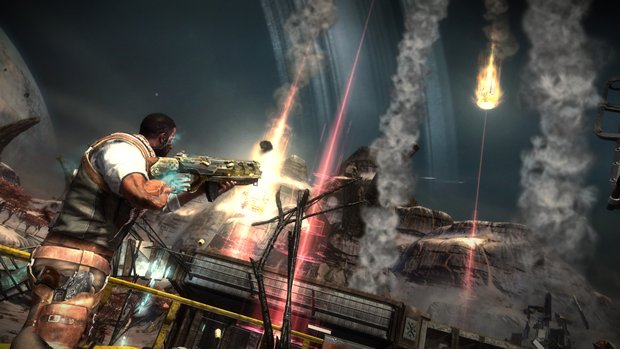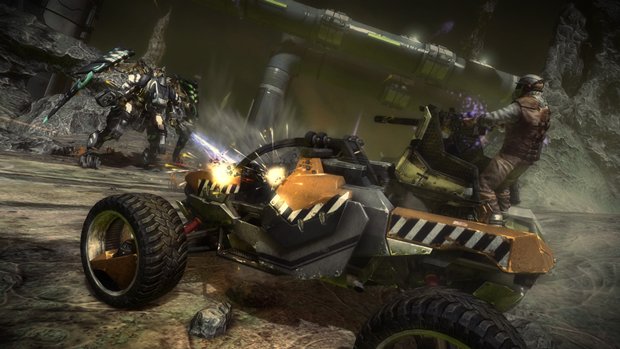E3 2011: Starhawk preview – why just join the army when you can build your own?
Destroy build destroy
Fact: robots are cool. Having full control over your very own robot is even cooler. The coolest, though, is having the ability to create those robots whenever you damn well please. And then ride them into battle. Starhawk is all about being cool.
As the successor to 2007's Warhawk, Starhawk seeks to take what made the first game one of the most popular shooters on the PSN and add a ton more. Obviously, it's got the vehicular combat and third person shooting from the first game, but because it takes place much further into the future, it's also been given some sweet new sci-fi powers.

Taking place in huge, open maps, Starhawk's battles are focused around players building up their bases on the fly. Need a sniper tower to pick off the opposing team's stragglers? Go right ahead and build that wherever you want. Need to get to the other side of the map quickly? Plop down a garage and start spawning some 4x4's to take you over the hills and through the woods to the enemy's base. Anywhere you need just about anything is a great location to build upon.
The single player mode is somewhere between a tower defense game and a third person shooter. Enemies come in waves and it's your job to build up your defenses so as to not allow them to destroy everything. It moves very quickly and the fighting and building elements are fairly seamless. In multiplayer, that fluidity between the two styles of gameplay is even more apparent. Any player on the team can build anything at any time, allowing for instant responses to threats and enemy strategies right when they need them.

As players continue to shape their respective bases, the way the game plays out begins to change dramatically. If no one builds a sniper tower, for example, there won't be any snipers spawning on the map. It seems like a little and slightly obvious detail, but what begins to happen is that buildings function as strategic attacks and counters, rather than simply being spawn points. It's a cool approach to the multiplayer shooter that eschews the traditional spawn, die, spawn gameplay that pervades the average deathmatch shooter these days.
Of course, resources are needed for constructing all of this stuff. As you throw down constructs, it costs Energy points, which are gained through completing various objectives. More offensive players will get points by killing opponents, while players that choose to stay on the defensive are usually funded by taking advantage of one of the Rifts that appear close to the bases. Building up defenses around an Extractor placed on a Rift is a vital strategy for getting enough Energy points for building huge and powerful weapons.

Among the most fun of the late game weapons are the mech-like Hawks. Expensive as all get out to build, they're more than capable of turning the tide of a battle simply by flying over and dropping into the middle of it. They're essentially Transformers with massive mounted guns, which we certainly have no complaints about. Adding to the aerial chaos is the drop pods that players spawn in. Assuming your enemy is somewhere within your spawning area, landing on top of them with a drop pod can do more damage than anything else in the game, and is plenty to do some serious damage to even a Hawk. Watching players attempt to pull off that particular strategy promises to be hilarious to watch.
Weekly digests, tales from the communities you love, and more
For those genre-challenged gamers out there, Starhawk is a godsend. Somewhere between real-time strategy, multiplayer-focused shooting, and tower defense, it's certainly avoiding being pinned down. Just as long as they keep all the elements working well, the PSN could have a new king of multiplayer on its hands.
Jun 10, 2011
Taylor Cocke is a Los Angeles-based writer and producer who spends too much time watching numbers go up in MMOs and ARPGs. You name it, he's written and/or produced for them, which is shocking considering the aforementioned MMO playing.


